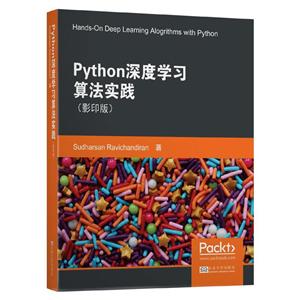扫一扫
关注中图网
官方微博
本类五星书更多>
-
>
决战行测5000题(言语理解与表达)
-
>
软件性能测试.分析与调优实践之路
-
>
第一行代码Android
-
>
深度学习
-
>
Unreal Engine 4蓝图完全学习教程
-
>
深入理解计算机系统-原书第3版
-
>
Word/Excel PPT 2013办公应用从入门到精通-(附赠1DVD.含语音视频教学+办公模板+PDF电子书)
Python深度学习算法实践(影印版) 版权信息
- ISBN:9787564189693
- 条形码:9787564189693 ; 978-7-5641-8969-3
- 装帧:一般胶版纸
- 册数:暂无
- 重量:暂无
- 所属分类:>
Python深度学习算法实践(影印版) 内容简介
本书深入浅出地剖析了深度学习的原理和相关技术。书中使用Python,从基本的数学知识出发,带领读者从零创建一个经典的深度学习网络,使读者在此过程中逐步理解深度学习。书中不仅介绍了深度学习和神经网络的概念、特征等基础知识,对误差反向传播法、卷积神经网络等也有深入讲解,此外还介绍了深度学习相关的实用技巧,自动驾驶、图像生成、强化学习等方面的应用,以及为什么加深层可以提高识别精度等疑难的问题。
Python深度学习算法实践(影印版) 目录
Preface
Section 1" Getting Started with Deep Learning
Chapter 1: Introduction to Deep Learning
What is deep learning?
Biological and artificial neurons
ANN and its layers
Input layer
Hidden layer
Output layer
Exploring activation functions
The sigmoid function
The tanh function
The Rectified Linear Unit function
The leaky ReLU function
The Exponential linear unit function
The Swish function
The softmax function
Forward propagation in ANN
How does ANN learn?
Debugging gradient descent with gradient checking
Putting it all together
Building a neural network from scratch
Summary
Questions
Further reading
Chapter 2: Getting to Know TensorFIow
What is TensorFIow?
Understanding computational graphs and sessions
Sessions
Variables, constants, and placeholders
Variables
Constants
Placeholders and feed dictionaries
Introducing TensorBoard
Creating a name scope
Handwritten digit classification using TensorFIow
Importing the required libraries
Loading the dataset
Defining the number of neurons in each layer
Defining placeholders
Forward propagation
Computing loss and backpropagation
Computing accuracy
Creating summary
Training the model
Visualizing graphs in TensorBoard
Introducing eager execution
Math operations in TensorFIow
TensorFIow 2.0 and Keras
Bonjour Keras
Defining the model
Defining a sequential model
Defining a functional model
Compiling the model
Training the model
Evaluating the model
MNIST digit classification using TensorFIow 2.0
Should we use Keras or TensorFIow?
Summary
Questions
Further reading
Section 2: Fundamental Deep Learning Algorithms
Chapter 3: Gradient Descent and Its Variants
Demystifying gradient descent
Performing gradient descent in regression "
Importing the libraries
Preparing the dataset
Defining the loss function
Computing the gradients of the loss function
Updating the model parameters
Gradient descent versus stochastic gradient descent
Momentum-based gradient descent
Gradient descent with momentum
Nesterov accelerated gradient
Adaptive methods of gradient descent
Setting a learning rate adaptively using Adagrad
Doing away with the learning rate using Adadelta
Overcoming the limitations of Adagrad using RMSProp
Adaptive moment estimation
Adamax - Adam based on infinity-norm
Adaptive moment estimation with AMSGrad
……
Section 3 Advanced Deep Learning Algorithms
展开全部
书友推荐
- >
姑妈的宝刀
姑妈的宝刀
¥9.0¥30.0 - >
中国人在乌苏里边疆区:历史与人类学概述
中国人在乌苏里边疆区:历史与人类学概述
¥34.1¥48.0 - >
【精装绘本】画给孩子的中国神话
【精装绘本】画给孩子的中国神话
¥18.7¥55.0 - >
朝闻道
朝闻道
¥8.8¥23.8 - >
李白与唐代文化
李白与唐代文化
¥8.9¥29.8 - >
伊索寓言-世界文学名著典藏-全译本
伊索寓言-世界文学名著典藏-全译本
¥9.3¥19.0 - >
经典常谈
经典常谈
¥12.7¥39.8 - >
新文学天穹两巨星--鲁迅与胡适/红烛学术丛书(红烛学术丛书)
新文学天穹两巨星--鲁迅与胡适/红烛学术丛书(红烛学术丛书)
¥9.9¥23.0
本类畅销
-
C专家编程
¥41¥69 -
UG NX 11.0工程图教程-(含1DVD)
¥30.4¥59.9 -
网络爬虫进化论——从Excel爬虫到Python爬虫
¥55.5¥79 -
Python 数据分析基础
¥41¥69 -
Python 3.5从零开始学
¥26.4¥59 -
湖北交通文化
¥21.8¥46





















